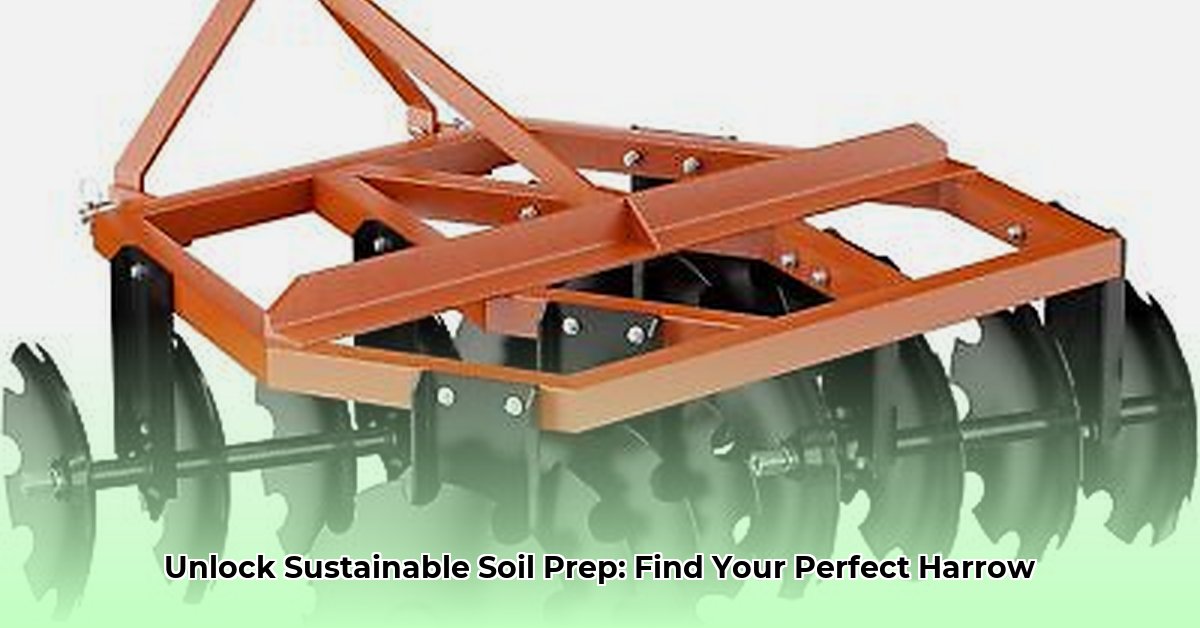
Choosing the right disc harrow for your tractor is crucial for efficient and sustainable soil preparation. This guide provides a comprehensive overview of disc harrow types, selection criteria, operation, maintenance, and sustainability considerations, empowering you to make an informed decision for your farm. For more information on tractor brands, see this helpful resource.
Types of Disc Harrows: A Comparative Analysis
Disc harrows come in various designs, each suited to different soil types and farming operations. Understanding these differences is key to selecting the right tool for your needs.
Tandem Disc Harrows: These heavy-duty harrows feature two rows of discs, providing aggressive tillage ideal for breaking up compacted clay soils. They offer excellent leveling and create a uniform seedbed. However, they require higher horsepower tractors and are more expensive. Think of them as the workhorses of the disc harrow world, perfect for large-scale operations.
Single Disc Harrows: Lighter and more maneuverable than tandem harrows, these feature a single row of discs. They're suitable for smaller farms, lighter soils, and situations requiring more precise control. Single disc harrows are generally more affordable and require less tractor horsepower. They are a good option for smaller operations or lighter tillage needs.
Offset Disc Harrows: These harrows have a single gang of discs offset to one side, providing excellent control for contour farming on hilly terrain. This design helps prevent soil erosion and allows for precise tillage along slopes. While more specialized, their precision makes them a valuable asset in challenging terrains.
Comparing Brands: Everything Attachments vs. Agri Supply (and Others)
While direct comparisons between specific Everything Attachments and Agri Supply models are beyond the scope of this guide, remember that the origin and quality of components significantly impact durability, performance, and longevity. American-made components often prioritize higher safety standards and superior materials. Researching specific models from different manufacturers is crucial for making an informed decision based on your specific needs and budget.
Choosing the Right Harrow: A Step-by-Step Framework
Selecting the optimal disc harrow involves careful consideration of several key factors. This step-by-step guide helps navigate the decision-making process.
Step 1: Analyze Your Soil Type: Heavy clay soils necessitate a robust tandem harrow for effective tilling, while lighter soils might be adequately prepared with a single disc harrow. Soil texture and drainage significantly influence harrow selection.
Step 2: Evaluate Your Farm Size: Large farms benefit from the efficiency of wider harrows, covering more ground per pass, while smaller farms might find a more compact and maneuverable harrow easier to operate.
Step 3: Define Your Budget: Disc harrows range widely in price, with advanced features like adjustable angles and offset discs commanding a premium. Budget constraints must be incorporated early in the selection process. Consider lease options for high-end equipment.
Step 4: Prioritize Sustainability Goals: American-made harrows often reduce transportation emissions, contributing to a smaller carbon footprint. Look for manufacturers committed to sustainable manufacturing practices, minimizing environmental impact. Research brands committed to using recycled materials and energy-efficient production.
Harrow Operation and Maintenance: Practical Instructions
Proper operation and regular maintenance are vital for maximizing the lifespan and efficiency of your disc harrow.
1. Adjusting the Harrow: Most harrows allow for adjustments to disc angle and depth. Proper adjustment depends heavily on soil conditions – adjustments are crucial for optimal tillage and soil preparation.
2. Safe Operating Procedures: Always operate at a safe speed, ensuring overlapping passes for even soil coverage. Avoid overloading the harrow or your tractor, and always use appropriate safety equipment.
3. Routine Maintenance: Regular maintenance includes lubricating moving parts, sharpening or replacing worn discs, and inspecting the frame for damage. This preventative maintenance significantly extends the equipment's lifespan and prevents costly repairs.
Sustainability Considerations: Environmental Impact
Sustainability extends beyond material sourcing and encompasses efficient design and use. Prioritize lightweight designs that reduce fuel consumption during operation. Minimizing soil disturbance through appropriate tillage practices helps conserve soil health and reduce erosion. Consider no-till or reduced-till farming methods to sequester carbon in the soil.
Case Studies: Real-World Applications
(This section would incorporate real-world examples demonstrating the effectiveness of different disc harrow types in various soil conditions and farm sizes. Ideally, this would include data on yield improvements, fuel efficiency, time savings, and other relevant metrics.) These narratives would provide practical insights into how different harrows perform in diverse situations.
Conclusion: Making Informed Decisions for Sustainable Tillage
Choosing the right disc harrow is a crucial investment for any farm. By carefully considering the factors outlined in this guide—soil type, farm size, budget, and sustainability goals—farmers can make well-informed decisions that lead to efficient and sustainable soil preparation. Remember, the right harrow can significantly enhance your operational efficiency and contribute to a more productive and environmentally responsible farm.